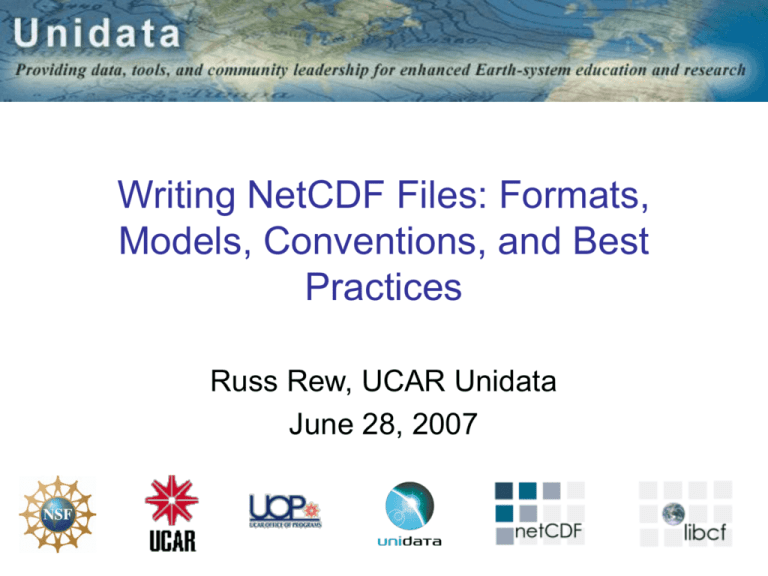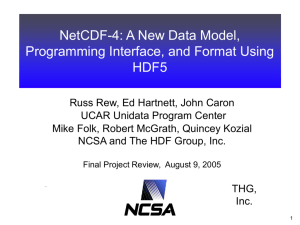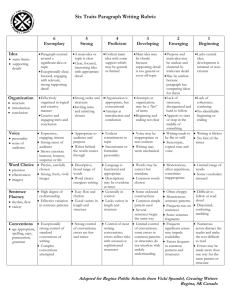Developing Conventions for netCDF-4
advertisement

Writing NetCDF Files: Formats,
Models, Conventions, and Best
Practices
Russ Rew, UCAR Unidata
June 28, 2007
1
Overview
• Formats, conventions, and models
• NetCDF-3 limitations
• NetCDF-4 features: examples and
potential uses
• Compatibility issues
• Conventions issues
• Recommendations
2
Data Abstraction Levels:
Formats, Conventions, and Models
Data
Models
Data
Conventions
netCDF
classic
CF-1.0
HDF-EOS
Data
Formats
BUFR
netCDF/CF
netCDF
User Guide
netCDF classic
GRIB1
CDM
(netCDF-4)
Unidata
Obs
HDF5
GRIB2
HDF5
ARGO
netCDF-4
CDL
3
NetCDF Formats
2007
2005
2002
1988
netCDF-4 (HDF5-based)
64-bit offset variant
NcML (XML-based)
“classic” format
CDL (text-based)
4
Commitment to Backward Compatibility
Because preserving access to archived data for
future generations is sacrosanct :
Data access: New netCDF software will provide read
and write access to all earlier forms of netCDF data.
APIs and programs: Existing C, Fortran, and Java
netCDF programs will be supported by new netCDF
software (possibly after recompiling).
Commitment: Future versions of netCDF software will
continue to support data access, API, and conventions
compatibility.
5
Purpose of Data Conventions
•
•
•
•
•
To capture meaning in data
To make files self-describing
To faithfully represent intent of data provider
To foster interoperability
To add value to formats
– Raise level of abstraction (e.g. adding coordinate
systems)
– Customize format for discipline or community (e.g.
climate modeling)
CF-1.0
netCDF
User Guide
Unidata
Obs
ARGO
…
6
NetCDF conventions
• Users Guide conventions:
– Simple coordinate variables (same name for dimension and
variable)
– Common attributes: units, long_name, valid_range,
scale_factor, add_offset, _FillValue, history,
Conventions, …
– Not just for earth-science data
• Followed by lots of community conventions:
COARDS, GDT, NCAR-RAF, ARGO, AMBER, PMELEPIC, NODC, …, CF
• Unidata Obs Conventions for netCDF-3 (supported
by Java interface)
• Climate and Forecast conventions (CF) endorsed by
Unidata (2005)
• Unidata committed to development of libcf (2006)
7
CF Conventions (cfconventions.org)
• Clear, comprehensive, consistent (thanks to Eaton,
Gregory, Drach, Taylor, Hankin)
• standard_name attribute for identifying quantities,
comparison of variables from different sources
• Coordinate systems support
• Grid cell bounds and measures
• Acceptance by community: IPCC AR4 archive, …
• Governance and stewardship: GO-ESSP, BADC,
PCMDI, WCRP/WGCM (pending)
8
CF Conventions Issues
• cf-metadata mailing list
• cfconventions.org site: documents, forums,
wiki, Trac system
• GO-ESSP annual meetings
• Recent CF issues and proposed CF extensions
– Structured grids, staggered grids, subgrids, curvilinear
coordinates (Balaji)
– Unstructured grids (Gross)
– Forecast time axis (Gregory, Caron)
– Means and subgrid variation and anomaly modifier for
standard names
– Additions needed for observational data
– NetCDF-4 issues
– Needs for IPCC AR5 model output archives
9
Scientific Data Models
Relational
GIS
netCDF
classic
CDM
(netCDF-4)
HDF5
• Tabular data
– Relational model
– Tuples, types, queries, operations, normalization, integrity constraints
• Geographic data
– GIS models
– Features and coverages, observations and measurements
– Adds spatial location to relational model
• Multidimensional array data
– Basis of netCDF, HDF models
– Dimensions, variables, attributes
• Scientific data types
– Coordinate systems, groups, types: structures, varlens, enums
– N-dimensional grids, in situ point observations, profiles, time series,
trajectories, swaths, …
10
NetCDF Data Models
• “Classic” netCDF model (netCDF-3 and
earlier)
– Dimensions, Variables, and Attributes
– Character arrays and a few numeric types
– Simple, flat
• CDM (netCDF-4 and later)
– Dimensions, Variables, Attributes, Groups, Types
– Additional primitive types including strings
– User-defined types support structures, variablelength values, enumerations
– Power of recursive structures: hierarchical groups,
nested types
11
Classic NetCDF Data Model
File
Variables and attributes
have one of six primitive
data types.
location: Filename
create( ), open( ), …
Attribute
Dimension
name: String
type: DataType
values: 1D array
DataType
name: String
length: int
isUnlimited( )
Variable
name: String
shape: Dimension[ ]
type: DataType
array: read( ), …
char
byte
short
int
float
double
A file has named variables, dimensions, and attributes. A
variable may also have attributes. Variables may share
dimensions, indicating a common grid. One dimension may
be of unlimited length.
12
Some Limitations of Classic NetCDF
Data Model and Format
• Little support for data structures, just
multidimensional arrays and lists
• No nested structures or “ragged arrays”
• Only one shared unlimited dimension for appending
new data efficiently
• Flat name space for dimensions and variables
• Character arrays rather than strings
• Small set of numeric types
• Constraints on sizes of large variables
• No compression, just packing
• Schema additions may be very inefficient
• Big-endian bias may hamper performance on littleendian platforms
13
NetCDF-4 Data Model
Variables and attributes have one of twelve primitive
data types or one of four user-defined types.
File
location: Filename
create( ), open( ), …
DataType
Group
UserDefinedType
name: String
typename: String
Dimension
Attribute
Enum
name: String
name: String
type: DataType
values: 1D array
length: int
Opaque
isUnlimited( )
Compound
Variable
name: String
shape: Dimension[ ]
type: DataType
array: read( ), …
VariableLength
PrimitiveType
char
byte
short
int
int64
float
double
unsigned byte
unsigned short
unsigned int
unsigned int64
string
A file has a top-level unnamed group. Each group may contain
one or more named subgroups, user-defined types, variables,
dimensions, and attributes. Variables also have attributes.
Variables may share dimensions, indicating a common grid. One
or more dimensions may be of unlimited length.
14
NetCDF-4 Format and Data Model
Benefits
HDF5-based format provides:
• Per-variable compression
• Per-variable
multidimensional tiling
(chunking)
• Ample variable sizes
• Reader-makes-right
conversion
• Efficient dynamic schema
additions
• Parallel I/O
New data model provides:
• Groups for nested scopes
• User-defined enumeration
types
• User-defined compound
types
• User-defined variablelength types
• Multiple unlimited
dimensions
• String type
• Additional numeric types
15
Chunking
• Allows efficient access of multidimensional data
along multiple axes
• Compression applies separately to each chunk
• Can improve I/O performance for very large arrays
and for compressed variables
• Default chunking parameters are based on a size of
one in each unlimited dimension
index order
chunked
16
NetCDF-4 Data Model Features
• Examples in “CDL-4”
–
–
–
–
•
•
•
•
Groups
Compound types
Enumerations
Variable-length types
Not necessarily best practices
Other potential known uses
Advice on known limitations
Potential conventions issues
17
Example Use of Groups
Organize data by named property, e.g. region:
group Europe {
group France {
dimensions: time = unlimited, stations = 47;
variables: float temperature(time, stations);
}
group England{
dimensions: time = unlimited, stations = 61;
variables: float temperature(time, stations);
}
group Germany {
dimensions: time = unlimited, stations = 53;
variables: float temperature(time, stations);
}
…
dimensions: time = unlimited;
variables: float average_temperature(time);
}
18
Potential Uses for Groups
• Factoring out common information
– Containers for data within regions, ensembles
– Model metadata
• Organizing a large number of variables
• Providing name spaces for multiple uses of
same names for dimensions, variables,
attributes
• Modeling large hierarchies
19
Example Use of Compound Type
Vector quantity, such as wind:
types:
compound wind_vector_t {
float eastward ;
float northward ;
}
dimensions:
lat = 18 ;
lon = 36 ;
pres = 15 ;
time = 4 ;
variables:
wind_vector_t gwind(time, pres, lat, lon) ;
wind:long_name = "geostrophic wind vector" ;
wind:standard_name = "geostrophic_wind_vector" ;
data:
gwind = {1, -2.5}, {-1, 2}, {20, 10}, {1.5, 1.5}, ...;
20
Another Compound Type Example
Point observations :
types:
compound ob_t {
int station_id ;
double time ;
float temperature ;
float pressure ;
}
dimensions:
nstations = unlimited ;
variables:
ob_t obs(nstations) ;
data:
obs = {42, 0.0, 20.5, 950.0}, … ;
21
Potential Uses for Compound Types
•
•
•
•
Representing vector quantities like wind
Modeling relational database tuples
Representing objects with components
Bundling multiple in situ observations together
(profiles, soundings)
• Providing containers for related values of other userdefined types (strings, enums, …)
• Representing C structures portably
• CF Conventions issues:
– should type definitions or names be in conventions?
– should member names be part of convention?
– should quantities associated with groups of compound
standard names be represented by compound types?
22
Drawbacks with Compound Types
• Member fields have type and name, but are
not netCDF variables
• Can’t directly assign attributes to compound
type members
– New proposed convention solves this problem, but
requires new user-defined type for each attribute
• Compound type not as useful for Fortran
developers, member values must be
accessed individually
23
Example Convention for Member Attributes
types:
compound wind_vector_t {
float eastward ;
float northward ;
}
compound wv_units_t {
string eastward ;
string northward ;
}
dimensions:
station = 5;
variables:
wind_vector_t wind(station) ;
wv_units_t wind:units = {"m/s", "m/s"} ;
wind_vector_t wind:_FillValue = {-9999, -9999} ;
data:
wind = {1, -2.5}, {-1, 2}, {20, 10}, ... ;
24
Example Use of Enumerations
Named flag values for improving self-description:
types:
byte enum cloud_t {
Clear = 0, Cumulonimbus = 1, Stratus = 2,
Stratocumulus = 3, Cumulus = 4, Altostratus = 5,
Nimbostratus = 6, Altocumulus = 7, Missing = 127
};
dimensions:
time = unlimited;
variables:
cloud_t primary_cloud(time);
cloud_t primary_cloud:_FillValue = Missing;
data:
primary_cloud = Clear, Stratus, Cumulus, Missing, …;
25
Potential Uses for Enumerations
• Alternative for using strings with flag_values
and flag_meanings attributes for quantities
such as soil_type, cloud_type, …
• Improving self-description while keeping data
compact
• CF Conventions issues:
– standardize on enum type definitions and
enumeration symbols?
– include enum symbol in standard name table?
– standardize way to store descriptive string for
each enumeration symbol?
26
Example Use of Variable-Length Types
In situ observations:
types:
compound obs_t {
// type
float pressure ;
float temperature ;
float salinity ;
}
obs_t some_obs_t(*) ;
// type
compound profile_t {
// type
float latitude ;
float longitude ;
int time ;
some_obs_t obs ;
}
profile_t some_profiles_t(*) ; // type
compound track_t {
// type
string id ;
string description ;
some_profiles_t profiles;
}
dimensions:
tracks = 42;
variables:
track_t cruise(tracks); // this cruise
for a single observation
for some observations
for a single profile
for some profiles
for a single track
has 42 tracks
27
Potential Uses for Variable-Length Type
• Ragged arrays
• In situ observational data (profiles,
soundings, time series)
28
Notes on netCDF-4 Variable-Length Types
• Variable length value must be accessed all at
once (e.g. whole row of a ragged array)
• Any base type may be used (including
compound types and other variable-length
types)
• No associated shared dimension, unlike
multiple unlimited dimensions
• Due to atomic access, using large base types
may not be practical
29
Recommendations and Best
Practices …
30
NetCDF Data Models and File Formats
Data providers writing new netCDF data have
two obvious alternatives:
1. Use netCDF-3: classic data model and
classic format
2. Use richer netCDF-4 data model and
netCDF-4 format
and a third less obvious choice:
3. Use classic data model with the netCDF-4
format
31
Third Choice: “Classic model” netCDF-4
• Psuedo format supported by netCDF-4 library
with file creation flag
• Ensures data can be read by netCDF-3
software (relinked to netCDF-4 library)
• Compatible with current conventions
• Writers get performance benefits of new
format
• Readers can
– access compressed or chunked variables
transparently
– get performance benefits of reader-makes-right
– use HDF5 tools on files
32
NetCDF-4 Format and Data Model
Benefits
HDF5-based format provides:
• Per-variable compression
• Per-variable
multidimensional tiling
(chunking)
• Ample variable sizes
• Reader-makes-right
conversion
• Efficient dynamic schema
additions
• Parallel I/O
New data model provides:
• Groups for nested scopes
• User-defined enumeration
types
• User-defined compound
types
• User-defined variablelength types
• Multiple unlimited
dimensions
• String type
• Additional numeric types
33
Why Not Make Use of
NetCDF-4 Data Model Now?
• C-based netCDF-4 software still only in beta release
(depending on HDF5 1.8 release)
• Few netCDF utilities or applications adapted to full
netCDF-4 model yet
• Development of useful conventions will take
experience, time
• Significant performance improvements available now,
without netCDF-4 data model
– using classic model with netCDF-4 format
34
When to Use NetCDF-4 Data Model
• On “greenfield projects” (lacking legacy issues or
constraints of prior work)
• If non-classic primitive types needed
– 64-bit integers for statistical applications
– unsigned bytes, shorts, or ints for wider range
– real strings instead of fixed-length char arrays
• If making data self-descriptive requires new userdefined types
–
–
–
–
compound
variable-length
enumerations
nested combinations of types
• If multiple unlimited dimensions needed
• If groups needed for organizing data in hierarchical
name scopes
35
Recommendations for Data Providers
• Continue using classic data model and
format, if suitable
• Evaluate practicality and benefits of
classic model with netCDF-4 format
• Test and explore uses of extended
netCDF-4 data model features
• Help evolve netCDF-4 conventions and
Best Practices based on experience
with what works
36
Best Practices: Where to Go From Here
• We’re updating current netCDF-3 Best
Practices document before Workshop in July
• New “Developing Conventions for NetCDF-4”
document is under development
• Benchmarks may help with guidance on
compression, chunking parameters, use of
compound types
• We depend on community experience for
distillation into new Best Practices
37
Adoption of NetCDF-4: A Three-Stage
Chicken and Egg Problem
• Data providers
– Won’t be first to use features not supported by
applications or standardized by conventions
• Application developers
– Won’t expend effort needed to support features
not used by data providers and not standardized
as published conventions
• Convention creators
– Likely to wait until data providers identify needs
for new conventions
– Must consider issues application developers will
confront to support new conventions
38
Thanks!
Questions?
39
F90
apps
for
netCDF-3
Java
Apps
for
netCDF
C
apps
for
netCDF-3
Perl,
F77
C++
Python,
apps
apps
Ruby, …
for
for
apps
netCDF-3
netCDF-3
for
netCDF-3
netCDF-3
F90
library
netCDF-3
F77
library
netCDF
Java
library
C
apps
for
netCDF-4
netCDF-3
netCDF-3
Perl,
C++
Python,
library
Ruby, …
libraries
C
apps
for
HDF5
F90
apps
for
HDF5
Java
apps
for
HDF5
HDF5
F90
library
HDF5
Java
library
netCDF-4
F90
library
netCDF-4 C library
netCDF-3 C library
JVM
F90
apps
for
netCDF-4
HDF5 C library
Posix I/O
MPI I/O
zlib, …
Operating system
40





